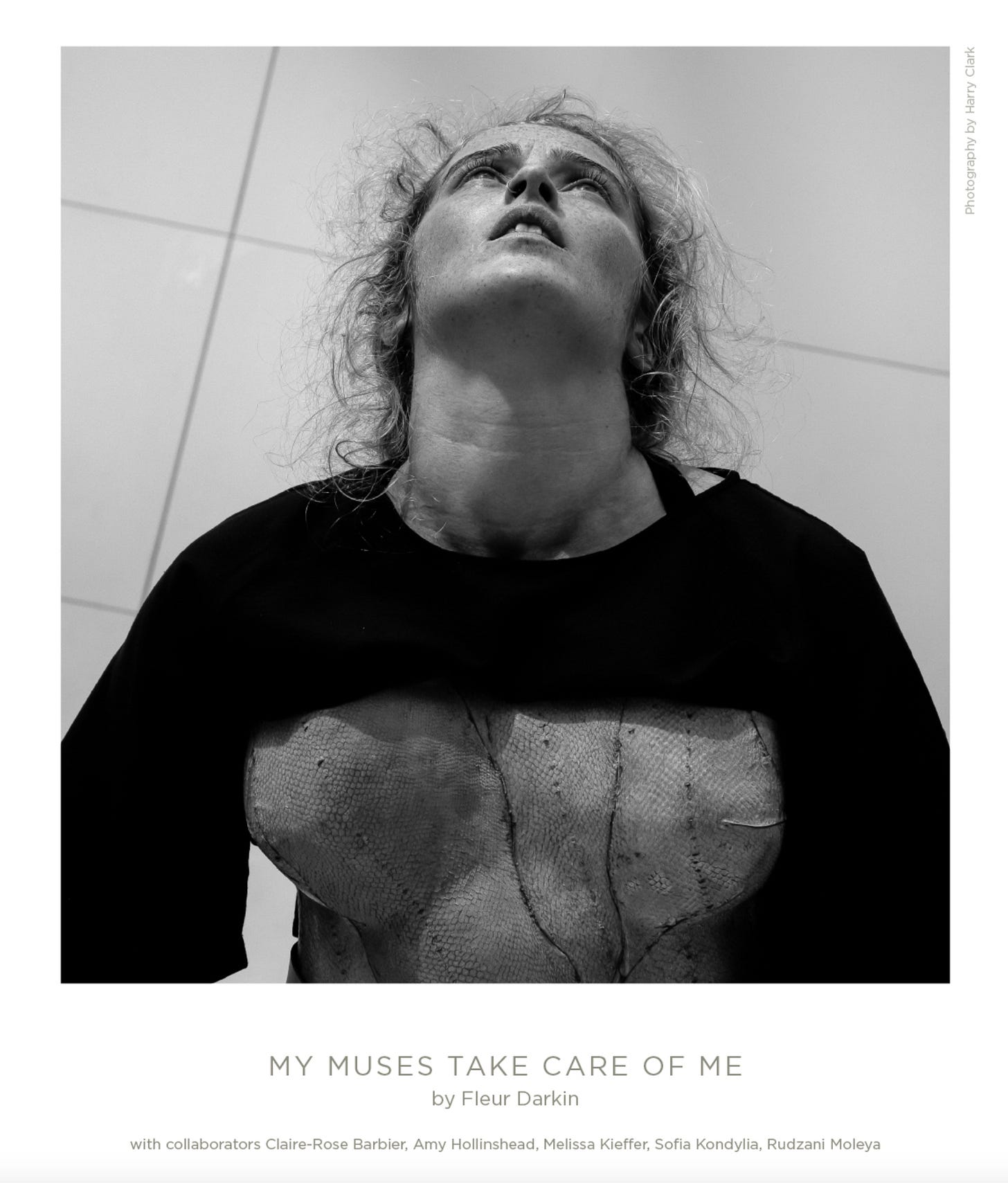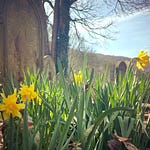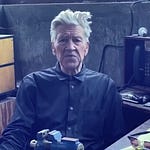It’s not possible to constantly hold onto a crisis. You have to have the love and you have to have the magic – Toni Morrison
Helmut & Kerry, Corriedoo, Galloway & Dumfries, Scotland, April 2025
As forests burn
Kerry and Helmut live on the edge of a forest in a remote part of southwest Scotland where the sky is so dark that, on a clear night, it rains with stars. On the fringes of the Sitka and its secret, hidden lochs, Kerry and Helmut keep bees, grow their own vegetables, walk their poodles Rosa and Cotton and make art. Helmut is an explorer of sound – the audible, inaudible and the imperceptible frequencies that can only be heard in the imaginal. Kerry makes ecological art in conversation with nature through walking, talking, listening, drawing and performing, alone and with others.
Helmut loves the experimental rock musician Captain Beefheart and has a shelf full of records dedicated to legendary bluesman Howlin’ Wolf. He sports a long white beard, dyed red at the tip, and looks like a magician. Famous, amongst many things, for his baking, whilst I was staying, Helmut rustled up a tray of anarchy buns, all perfectly scored with a capital A.
Kerry dresses in matching colours, with a preference for pastel, and on any given day may be spotted leaving the house head-to-toe in lemon, turquoise or salmon pink. She works two days a week for a non-profit carbon centre focused on peatland restoration where her job title is Artist and she looks like a rangy, brightly plumed, possibly mythical, bird.
Meanwhile, the field behind Kerry and Helmut’s house is a modular art installation whose individual parts include the hand-built cabin that’s home to Helmut’s organ pipes; Kerry’s giant priapic and bulbous wood sculptures modelled on plants and the upside down trees by artist-activist Gustav Metzger, reclaimed from a rubbish pile and bolted to the back wall of the barn, where they generously host those fortunate enough to be their friends including me.
Together, Kerry and Helmut have written ‘The Manifesto of Urgency’ which goes like this:
as forests burn and rivers burst
as cities scorch and mountains slip,
as glaciers melt and waters rise,
as storms ravage and tundras thaw,
as oceans choke and currents shift,
as landscapes change and species dies.
as we are us and they are them
and separation becomes the norm…
ARTISTS, there is the urgency to
create your own lines to tell the truth,
shout your tunes to reveal the cause,
use your moves to show connections,
let your structures take sides,
convert your sounds into revelations,
turn your objects into shelter,
construct your words to share solutions,
transform your colours into hope,
connect yourself with others…
Make Art Urgent
Make Urgent Art
In Jungian psychology, art is how the transpersonal enters the world through the personal. It’s not only a creative practice but a spiritual practice that connects us to the numinous and makes space for the ‘other’ which is nothing less than who we really are. How we make urgent art in a transitional time of uncertainty and chaos is what I had come to the forest to write about. Can creativity and the arts help us adapt to our time on the world clock? And, if so, how?
The last thing we wanted was normality
It was during my stay that I read my friend Charlie’s brilliant debut novel, Nova Scotia House. The backdrop to the Nova Scotia House is the AIDS crisis that swept through the gay community in 1980’s Britain. But the story inside the story narrated by gardener, baker and carer, Johnny as he looks back in mid-life on his great love Jerry, is that of the pioneering queers who spent their time bed-hopping between a Dionysian pursuit of the senses and an Apollonian world of ideas and art as a way to live outside the system.
It’s a novel, too, about capitalism, gentrification and the disused warehouses along the banks of the Thames that were briefly turned into utopian experiments in communal queer living. As queer elder, Gareth, poignantly observes:
Before the nightmare began, the last thing we wanted was normality. Our lives were dedicated to the pursuit of queer magic.
Decades after Jerry’s death, Johnny still lives in their old home, 1 Nova Scotia House, where he witnesses the colourful haunts of his youth torn down to make way for luxury apartments. As he wonders how to get the old magic back, Johnny follows the desires of his body and heart through the labyrinth of the city in search of belonging and connection until eventually the possibility of a new home appears on the horizon and he moves towards it without looking back. My first lesson in magic.
My muses take care of me
Back in my temporary utopia of the barn on the edge of the forest, news was filtering through of a global stock market crash, the warmest March on record in Europe and Israel’s renewed genocidal shelling of Gaza. The headlines brought home to me that collapse is happening everywhere, all at once, including here in the forest, large swathes of which were on fire just a few miles down the road. Even on my walks among the trees accompanied by the iridescent shimmer of the siskins darting between patches of shadow and light, it was hard to hold the all the rage and grief for what’s rapidly becoming the new normal.
So it was that I found myself, along with Helmut and Kerry, in an audience of precisely six in the darkened auditorium of the small community arts centre where we had come to see the dance work My Muses Take Care of Me by new wave British choreographer Fleur Darkin.
The performance began with a feather-covered figure staggering into the light like a newborn fawn, as a dreamlike voice warned us that the night is no place for humans. Other figures appeared. Merged, fused, broke like waves. Human, animal, other? It was hard to tell. Some were furred. Some plated in moulded body parts – breasts, elbows, backbone, knees – covered in scales and varnished blood red.
Spoken word poetry rippled into the glitzy pulse of shimmering techno into full-throated a capella and back again. The dancers drew me into their spell until it felt like some spectral part of me was rolling on the floor right there amongst them. The show notes explained that My Muses Take Care of Me had been inspired, in part, by the words of Toni Morrison who said ‘it’s not possible to constantly hold onto crisis. You have to have the love and you have to have the magic.’ My second lesson.
It’s quite simple, really
One evening over ratatouille, salad and white wine, the conversation turned to some of the things I’d been thinking and writing about. I wanted to know what Kerry and Helmut thought about the extent to which creativity is valued outside of the arts as the kind of meta skill we’re all going to need to navigate the times.
“Isn’t it great,” I said, “That Kerry has a job as an artist in a non-arts organisation? Surely, that’s a model for how creativity could be embedded in everything?’
“No, no, no!” countered Helmut. His beard shook and the darkness outside began to sound with the cry of hunting owls. “That’s not right at all. That’s still capitalism and it’s not how we’re going to solve anything. Any artist who works inside the system for long enough is always going to get corrupted by it in the end. Kerry’s lucky - she’s close to retirement. And she’s strong.”
“So, what do we do?”
“It’s quite simple really.” Without missing a beat, Helmut delivered my third lesson.
“We’ll all going to have to learn to become shamans.”
If you enjoyed this dispatch, do ‘heart’ & share so that others can find it
Let’s discuss in the comments
How do you use art & creativity to tell the truth & connect with others?
What does magic mean to you?















Share this post